-

初中英语外研版七年级下册《Module 5 Shopping》说课稿
二、教学目标1.知识与技能掌握下列单词:market, supermarket,biscuit, lemon, strawberry, Mother’s Day, size, take, may, try, try on,certainly, wait a minute, sale, price, sale, look. fresh2.过程与方法:1. 能够通过书面表达购物。2. 能够根据情景进行购物对话。3.情感态度与价值观:乐于参加运用英语的实践活动,了解别国文化。三、学习者特征分析这一模块内容的学习者,是七年级的学生。学生已经学过一些形式的特殊疑问句,像what can I do for you?/can I help you?这些购物句式 ,学生在学生在小学阶段已经学过,学生通过阅读,情景购物对话的练习,学生准确的进行购物的对话。
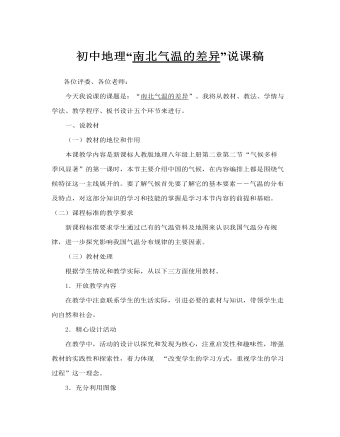
初中地理说课稿模板范文南北气温的差异
(一)教材的地位和作用 本课教学内容是新课标人教版地理八年级上册第二章第二节“气候多样 季风显著”的第一课时,本节主要介绍中国的气候,在内容编排上都是围绕气候特征这一主线展开的。要了解气候首先要了解它的基本要素--气温的分布及特点,对这部分知识的学习和技能的掌握是学习本节内容的前提和基础。(二)课程标准的教学要求 新课程标准要求学生通过已有的气温资料及地图来认识我国气温分布规律,进一步探究影响我国气温分布规律的主要因素。
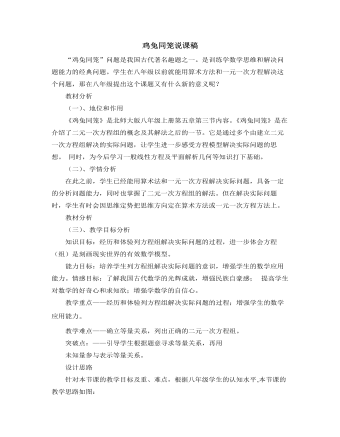
北师大版初中八年级数学上册鸡兔同笼说课稿
三、关于课本素材的处理课本素材:“鸡兔同笼”和“以绳测井”两个古代趣味问题。考虑到八年级学生独立思考和探索问题的能力都已达到一定的水平,特别增加了“自主探索,分层推进”这一环节,为每一位学生都提供了发展的空间。同时师生之间、学生之间共同研讨,形成教与学的和谐统一。凡能列二元一次方程组解决的问题,一般都可列一元一次方程来解,这就影响了用方程组去分析和解决问题,使学生形成思维定势。为此通过对“鸡兔同笼”多种求解方法的分析,使学生经历知识的发生过程,认识到列方程组的必要性和优越性,从而解决学生的思维定势的束缚。 以上是我对《鸡兔同笼》这一节课的一点思考,希望各位专家和老师指正,最后,我用布鲁克菲尔德的一句话来结束我的发言:让学生学会讨论、合作交流,讨论会使学生成为知识的共同创造者!
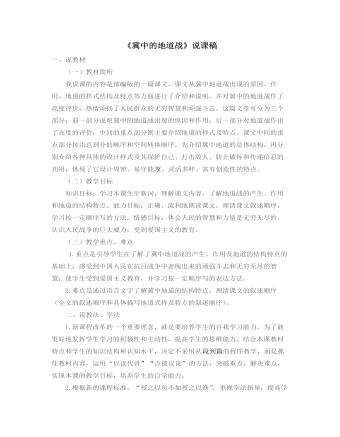
部编人教版五年级上册《 冀中的地道战》说课稿
一、说教材 (一)教材简析我说课的内容是部编版的一篇课文。课文从冀中地道战出现的原因、作用、地道的样式结构及特点等方面进行了介绍和说明,并对冀中的地道战作了高度评价,热情颂扬了人民群众的无穷智慧和顽强斗志。这篇文章可分为三个部分,前一部分说明冀中的地道战出现的原因和作用;后一部分对地道战作出了高度的评价;中间的重点部分则主要介绍地道的样式及特点。课文中间的重点部分按由总到分的顺序和空间转换顺序,先介绍冀中地道的总体结构,再分别介绍各种具体的设计样式及其保护自己、打击敌人、防止破坏和传递信息的功用,体现了它设计周密、易守能攻、灵活多样、富有创造性的特点。(二)教学目标知识目标:学习本课生字新词,理解课文内容,了解地道战的产生、作用和地道的结构特点。能力目标:正确、流利地朗读课文,理清课文叙述顺序,学习按一定顺序写的方法。情感目标:体会人民的智慧和力量是无穷无尽的,认识人民战争的巨大威力,受到爱国主义的教育。
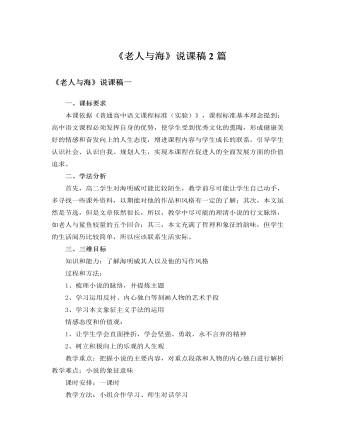
人教版高中语文必修3《老人与海》说课稿2篇
3、重要语句的理解“可是一个人并不是生来要给打败的,你尽可把它消灭掉,可就是打不败他。”解析:这是老人第一次回合之后的内心独白,也是此小说的核心精神,充分体现了老人桑地亚哥的生命理念。整句话可以分为两部分来理解,前句告诉我们,人生活在自然与社会当中,必不可少要面临一些坎坷、磨难,这些磨难、坎坷完全可以造成躯体的消灭、消亡,这是人生命的脆弱性。后句,面对挫折,只要保持一种乐观的精神,拥有一颗坚强的心灵,那么,人类执着奋斗的精神将永不磨灭。4、象征主义题目是《老人与海》,而表明上,小说是写一位老人及其在海上的经历,但实际上,老人的形象极具概括性,他已经超越了一个人的存在,而成为了人生的一种象征。老人桑地亚哥就是“硬汉子”的代表,大海则是生命旅途的象征,鲨鱼则是我们行走中的“强物”,厄运的象征。人的一生不可能一帆风顺,不经历风雨,怎能见彩虹,走在人生路途中,不可避免我们都要遇到挫折,被厄运所阻挠,只有经历与“鲨鱼”的较量,才能成为强者,唱出最美的歌。
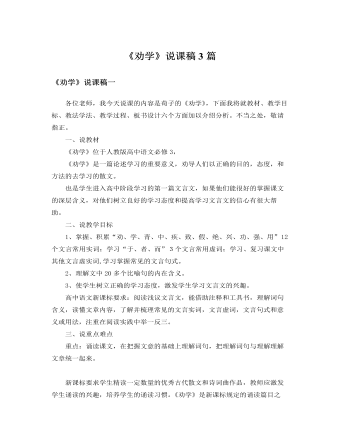
人教版高中语文必修3《劝学》说课稿3篇
《劝学》是普通高中课程标准试验教科书语文必修三第三单元的重点篇目,该文集中反映著名思想家荀子在学习问题上的观点和精彩斐然的论证艺术。该单元所选课文都是古代的议论性散文。通过本单元的学习在于让学生感受我国传统文化的精神,掌握基础的文言语法知识,学习如何清晰有力的表达自己的思想和见解。本文安排在单元的第一篇,如何指导学生学好这篇课文,是实现“授之以渔”,树立学生学好文言文的信心,掌握文言学习方法的关键。根据新课标倡导从“知识与能力”、“过程与方法”、“情感态度与价值观”三方面出发设计课程目标的要求和高一的学生对于文言文的知识还在积累的阶段,应该注重基础知识的积累和一定量的诵读的实际情况。我拟确定以下教学目标:1,了解荀子论述学习的思想,明确学习要靠积累、坚持不懈、专心致志的道理。2,掌握积累文言实词、虚词,活用、古今异议等现象和固定句式。
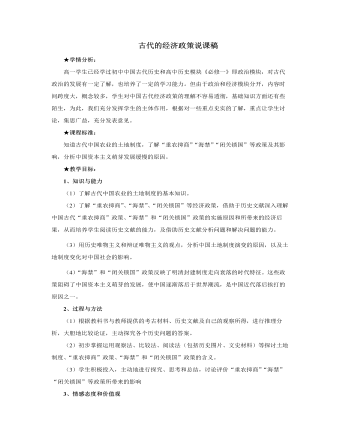
人教版高中历史必修2古代的经济政策说课稿
3、清代的“闭关锁国”政策:(1)原因:①根本原因:自给自足的封建自然经济;②客观原因:西方殖民者向东方殖民扩张;③直接原因:对付东南沿海人民的抗清斗争(2)内容:严格限制对外贸易。但并不是禁绝海外贸易。康熙晚期,禁止商人前往南洋贸易;乾隆时只开广州一处通商,并设立政府特许的贸易机构广州“十三行”统一经营管理对外贸易。(3)后果:①闭关锁国政策妨碍了海外市场的开拓,抑制了资本的原始积累,从而阻碍了资本主义萌芽的发展。②闭关锁国政策隔绝了中国与外界的联系,从而阻断了中国学习西方的先进科学技术,阻碍了生产力发展,使中国落后于世界潮流。③“闭关锁国”政策在一定程度上也保护了国家的安全。教师可以设置问题:17-18世纪中国显露出哪些危机?

人教版高中政治必修1新时代的劳动者说课稿
第一环节:关于劳动光荣和就业的意义。这两个问题学生在自主阅读的基础上,教师设疑,给出两个人物事迹,一是农民工刘俊刚把青春献给第二个家乡的城市美容师;一是北大学子李彦宏自主创业,创建百度公司,启发学生比较、思考。很多学生倾向于要做李彦宏,教师则适时引导:难道清洁工的劳动不重要吗?经过辩论,归纳出劳动和就业的意义。接着利用教材中李师傅的事例,进行问题探究,“李师傅找不到工作的原因是什么?”从主客观两方面分析,带着问题进入到下一环节学习。第二环节:突出重点。多媒体展示:通过数字的列举及对占有材料的分析,既看到了我国就业形势严峻,也介绍了国家关注民生,实施积极的就业政策。在此基础上,教师启发学生归纳“我国就业严峻的原因及对策?”学生把教材理论与生活中的现实材料相结合,进行探究,得出就业形势严峻的主要原因及其相应对策。

人教版高中英语必修2Cultural Relics说课稿2篇
Ⅲ. Analysis of the teaching material:The topic of this unit is cultural relics. Students are quite interested in topics about different cultures around the world. This is the second period of the whole unit. As a reading class, the passage mainly talks about the history of the amber room (how it was made, sent as a gift, lost and rebuilt).According to the new national curriculum, when teaching reading, much emphasis should be put on training the students’ reading skills.Ⅳ. Teaching objectives1. Language objectives:1) Students are required to master the key words and phrases occurred in the passage (e.g. amazing, decorate, belong, in return, less than etc.)2) Students are required to learn the attributive clause and acquire the sentence pattern.2. 1) Students are required to describe a certain thing by using the new sentence patterns.2) Students are required to master two kinds of reading skills—skimming and scanning, and learn to use them in their daily reading.3. 1) Students are required to know the history of the amber room.2) Students are required to appreciate cultural relics and understand the importance of protecting them.Ⅴ. Teaching important and difficult points1) the new words, phrases, and sentence pattern in the course of reading.2) Teaching difficult point: Help the students master two kinds of reading skills—skimmingand scanning and learn to apply them in daily use.Ⅵ. Teaching methods:Task-based method & Top-down model Ⅶ. Teaching aids: PPT, pictures, blackboard Ⅷ. Teaching procedure:

人教版高中英语必修3Astronomy the science of the stars说课稿3篇
Step 2 Pre-listeningAfter students finish their discussion, I will show a picture of Newton and ask them: Who is him? What is he famous for? Could you find out some words to describe him? Maybe students will answer that he is genius for his finding of theGravitation, making a great contribution to the progress of human being. At that time I will show another two pictures of Einstein and Hawking, letting students guess who they are and write down their idea about the Gravitation. For I have arranged them to search more information about the gravity before this class, Students have beenfamiliar with the topic and will not be afraid about this abstract conception, which is helpful for their listening.Step 3 While-listeningIn this step, students will be required to listen the material for three times. The first and listening is extensive listening and the second and third listening is intensive listening. In the first time, They are required to listen a material including Part 1 and Part 2 and choose the best summary of the listening text. After they choose the right answer, They also need work in group to explain what is wrong with the others. Then I will make a conclusion that we should pay attention to the first paragraph and last paragraph and some keys to get the main idea. By doing this, their capacity of generalization will have a great improvement.Before the second listening, I will ask students to scan the blank on the power point quickly and ask them to note down some key words .Then ask them to listen to the Part 1again and fill the first column of the chart. Maybe some students just show the ideas of these three scientists an still can’t catch their development of gravity. Therefore, I will ask them to listen to Part 2 again and fill in the rest. After finish the listening, I will give them ten minutes to discuss with their partner. I will also guidethem to improve their answers when they discuss with others.

人教版高中英语必修4A taste of English Humor说课稿3篇
Then I would ask them to think of a funny English or Chinese and tell it to partners. While telling stories, they can use expressions and some acting to help make the story funny. 5 minutes would be given to do this.Those stories they told there will be the material for their writing. Soletting them tell it at first is helpful. And they can make a difference between telling a funny story and writing it down. Generally speaking, it is difficult forstudents to write well because they don’t know what to write and how to write. Asking them to tell their own stories at first can help them come up with what to write.After their telling, I would invite someone to share his/her story with all of us and I would write it down on the blackboard.This example story would be used as a sample to illustrate the format of funny story. Different from a story from teacher or textbook, a story from students can obviously become a interesting material to draw students’ attention.Then I would ask the whole class to put this story into several parts. It might be a little bit difficult for them. So I would ask them to find out whether all the sentences are necessary. After delete some sentences, there are 6 sentences left behind. Then they can easily put them into three parts. After interaction with students, I would teach them the right terms for each part and conclude the format of funny story.This step is the key and difficult point in my lesson. So I mainly usetask-based teaching method in this part and the task for students was divided into several stages. With the separated difficult level, students can find there are usually three parts in writing. They can also learn to write without the unnecessary parts in the process of analyzing. And then I wouldn’t rush to tell them the right terms to them directly. Instead, I would ask them to name them by their own. A confused mind is better for acquiring knowledge.While-writing:Then I would give students 7 minutes to write down this story, without other requirements.With all the preparations in pre-writing, students’ difficulties were cleared. So it would be much easier for them to write down the story within 7 minutes. There are no other requirements because students’ first writing is actually a drafting. It would be revise and edit several times later. Writing, as a skill

人教版高中英语必修4Women of achievement说课稿4篇
Good morning, distinguished judges:It’s my honor to talk about my teaching ideas with you. Today my topic is Women of Achievement. My presentation consists of six parts: the analysis of teaching material and student, teaching aims, key and difficult points, teaching and studying method, teaching procedures and blackboard design.First, let’s focus on the analysis of teaching material. This lesson is from New Senior English for China Student’s Book 4 Unit 1, the reading part. The main topic of the passage is the introduction of a student of Africanwildlife. After this lesson, the students will learn more information about her studying chimps in Africa, and their reading and speaking abilities can be developed as well.The next part is the analysis of students. My students are in senior high students. They have learnt English for many years, they’ve known many words and sentences, but their speaking and reading abilities are still not very good. So I will practice their speaking and reading abilities through different exercises.According to the New Standard Curriculum and the present situation, I set the teaching aims as follows: firstly, knowledge aims. Students can grasp some new words, such as worthwhile, move off. Moreover, students can understand the content of the passage and get familiar with the topic of studying chimps in wildlife. Secondly, ability aims. Students can use reading strategies such as skimming and scanning in reading process. Thirdly, emotional aims. Students can have the awareness of protecting animals and care about animals.Based on the above analysis, the key point of this lesson is to get the main idea and the detailed information from the passage; the difficult point is to talk about the wildlife protection and use reading strategies.

人教版高中英语必修4Theme parks说课稿3篇
The oldest and the most popular park in the worldenjoy the exciting activities thereget close to the life-size cartoon characters like Mickey Mouse and Donald Duck Step 3 Pre-reading1.What do you suppose a theme park is ?2.What do you think you can see in a theme park?(1.It is a kind of amusement park which has a certain theme – that the whole park is based on. 2.buildings, castles, statues, rare animals and birds, and so on.) Step 4 Reading ----- Theme Parks –---- Fun and More Than Fun1.Predict : Read the title and the pictures on P. 34 and PredictWhat is the meaning of the title “Theme Park – Fun and more than fun”?(The title means that theme parks are fun to visit, but that they can also be educational and can offer useful information.)2.Skimming Fast read and answer:What activities can we take in a theme park?Amusement park: Bumper car Merry-go-round slide bungee jumping Free-fall rides Horror films Pirate ship Ferris wheel roller coaster3.Scanning Read again and you will find various theme parks are mentioned in the passage . Then what are they ?Theme parks: Sports theme park History theme park Culture theme park Marine or Ocean theme Park Future park Science theme park Disneyland4.Careful reading and find the main idea of each paragraph:THEME PARKS---- entertaining/ educationalPara.1 Traditional parks are places to go for relaxation and to have time away from our busy lives.Para.2 Theme parks are different They’re large and full of things to do, see and buy.Para.3 Theme parks are built around a single idea or theme. One example is a sports park.Para.4 Another kind of theme park is historical more and cultural and can be educational.Para.5 Disneylandwas the first theme park. It is based on the fantasy life and characters of Disney’s films.Para.6 Some examples of educational theme parks include sea world parks and science parks.

人教版高中英语必修4Working The Land说课稿3篇
Knowledge objectives:(1) to make Ss grasp the usage of words, expressions and sentence structures: statistics, struggle, thanks to, rid of, some patterns for persuasion, the “ing” form as subject and object;(2)to use learnt knowledge to persuade sb.Ability objectives:(1) to develop Ss’ reading skills(skimming, scanning, word guessing);(2) to improve Ss’ speaking, communicating and cooperating skills.Emotional objectives:to make Ss know the contribution of Yuan,and learn his spirit and his simple life time.Teaching important and difficult points:(1) some words, expressions and sentence structures mentioned above;(2)the content of the text;(3)training their reading and speaking skills.Teaching methods: CLT, TBLT,QT.Learning strategies: CLS, QLS, TBLS.Teaching procedures:Step 1 lead-in: (1) teacher plays a piece of recent news from CCTV about the harvest of the super hybrid rice, and ask students whether they know Yuan or not, and talk about him and his contribution.(2)Brain storm: let Ss describe Yuan in their minds including his appearance, his living condition and so on.Step 2 fast reading tasks:(1)teacher introduces Yuan and super hybrid rice(2)make Ss read the text as fast as possible with questions. Such as: what’s the general ideaof this passage? What’s Yuan’ dream? (skimming and scanning skill)Step 3 intensive reading tasks(1)let Ss read the text silently, find topic sentence of each paragraph and draw the difficult sentences and the knowledge what they don’t understand.(words guessing)(2)teacher and Ss talk about the important words, expressions and sentences together, and ask Ss to retell the content of the text.(summarizing and paraphrasing)(3)teacher summarize this part.(4) read again following the courseware.

人教版高中英语必修5First aid说课稿6篇
In this class, I have 3 teaching aims, that is, knowledge aims, ability aims and emotion aims.1) Knowledge-Teach students new words and expressions, such as temporary, bleed,sprain choke, first aid, fall ill and so on.-Enable students to have a better understanding for some basic knowledge of first aid.2) Ability-Train students’ speaking, reading and writing abilities by different teaching activities, such as skimming, comprehending, team work, role play, retelling and writing.-Develop students’ reading strategy on how to move general idea to specific information.3) Emotion-Promote students’ awareness of giving first aid.- Cultivate students’ creativities.Then let’s come to my teaching methods and activities.III. Teaching methods and activities:To achieve different teaching aims, various kinds of teaching methods and activities will be adopted throughout this period, such as TBL (task-based learning), skimming, team work, brainstorm and others, which can offer students opportunities to fulfill tasks in which they can use language to achieve a specific outcome.IV. Teaching aids:Computer and blackboardV. Teaching important points:1) Make students have a clear mind for the structure of the text.2) Help students understand the theme of the text.VI. Teaching difficulties:1) So many new words may affect students’ understanding.2) How to get students to know about the functions of the skin and thecauses, characteristics and treatments for different degree burns,and the knowledge about giving first aid. VII. Blackboard design:

人教版高中英语必修5Life in the Future说课稿5篇
Good afternoon, everyone. It’s my great pleasure to be here sharing my lesson with you. The content of my lesson is Senior English for China Book5 Unit 3 Life in the Future. I’ll be ready to begin this lesson from six parts: Analysis of the teaching material, Analysis of the students, Teaching aims and important and difficult points, Teaching methods and aids, Teaching procedures, and Blackboard design. First, let me talk about the teaching material.Part 1 Analysis of the Teaching Material:This unit is about what human beings’ life will be like in about one thousand years. By studying of this unit, we’ll Enable the students to know the changes in humans’ life and some new inventions bringing about the change and develop the interest in science. This lesson plays an important part in the English teaching in this unit. This is an important lesson in Book Five. From this lesson, it starts asking the Ss to grasp contents of each passage. Therefore, this lesson is in the important position of the teaching material. If the Ss can learn it well, it will be helpful to make the Ss learn the rest of this unit.Part 2 Analysis of the SsAs Senior2 Ss, they are at different levels of English fluency, some of them have lost interest in English. So during the lesson, I arrange a variety of activities to let all of them join in to attract their interest and let them be confident and taste the joy of success.

人教版高中英语必修5The United Kingdom说课稿4篇
Teaching Aims:Knowledge 1. Get the students to learn the useful new words and expressions in this section. Aims:2. Let the students learn about how the UK was formed and the four groups of invaders.1. Develop students’ reading ability and let them learn different Ability reading skills. Aims:2. Enable students to learn to talk about the United Kingdom and the Union Jack Emotional 1. Let students know more about the UK2. Develop students’ sense of cooperative learning Aims:Teaching Important Points:1. Let the students learn about the countries of the United Kingdom and the Union Jack2. Get the students to read the passage and know about how the UK was formed and the four groups of invaders.3. Have the students learn different reading skills.Teaching Difficult Ponts:1. Develop students’ reading ability.2. Enable students to talk about the United Kingdom and the Union Jack.3. Let students learn how the UK was formed geographically and historically.Teaching Methods:Showing pictures, asking, exercising, listening, reading etc.Teaching Aids:A computer,a projector and a blackboard.Teaching Procedures: 1) Show a map of the world, ask students the following questions:Where is the UK?What’s the full name of the UK?2) Ask the students work in pairs to do the quiz on Page 9.Do you want to test how many things you know about the United Kingdom? Let’s have a small test.Using the map on P9, students answer the following questions:?How many countries does the UK consist of? What are they??England is divided into three main areas. Do you know what they are? 1) Scanning (10Minutes )Let the students hold the questions asked in pre-reading and read the passagequickly and then let them do the following exercise.Join lines to the right answer.
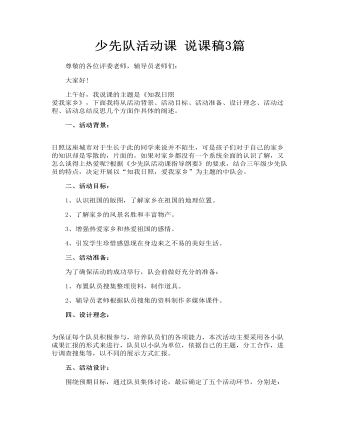
少先队活动课 说课稿3篇
一、活动背景: 日照这座城市对于生长于此的同学来说并不陌生,可是孩子们对于自己的家乡的知识却是零散的,片面的。如果对家乡都没有一个系统全面的认识了解,又怎么谈得上热爱呢?根据《少先队活动课指导纲要》的要求,结合三年级少先队员的特点,决定开展以“知我日照,爱我家乡”为主题的中队会。 二、活动目标: 1、认识祖国的版图,了解家乡在祖国的地理位置。 2、了解家乡的风景名胜和丰富物产。 3、增强热爱家乡和热爱祖国的感情。 4、引发学生珍惜感恩现在身边来之不易的美好生活。 三、活动准备: 为了确保活动的成功举行,队会前做好充分的准备: 1、布置队员搜集整理资料,制作道具。 2、辅导员老师根据队员搜集的资料制作多媒体课件。 四、设计理念: 为保证每个队员积极参与,培养队员们的各项能力,本次活动主要采用各小队成果汇报的形式来进行,队员以小队为单位,依据自己的主题,分工合作,进行调查搜集等,以不同的展示方式汇报。
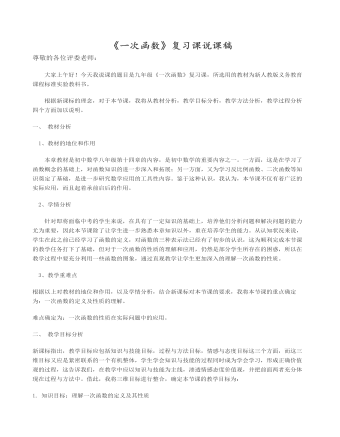
《一次函数》复习课说课稿
1、教材的地位和作用本章教材是初中数学八年级第十四章的内容,是初中数学的重要内容之一。一方面,这是在学习了函数概念的基础上,对函数知识的进一步深入和拓展;另一方面,又为学习反比例函数、二次函数等知识奠定了基础,是进一步研究数学应用的工具性内容。鉴于这种认识,我认为,本节课不仅有着广泛的实际应用,而且起着承前启后的作用。 2、学情分析针对即将面临中考的学生来说,在具有了一定知识的基础上,培养他们分析问题和解决问题的能力尤为重要,因此本节课除了让学生进一步熟悉本章知识以外,重在培养学生的能力。从认知状况来说,学生在此之前已经学习了函数的定义,对函数的三种表示法已经有了初步的认识,这为顺利完成本节课的教学任务打下了基础,但对于一次函数的性质的理解和应用,仍然是部分学生所存在的困惑,所以在教学过程中要充分利用一些函数的图象,通过直观教学让学生更加深入的理解一次函数的性质。
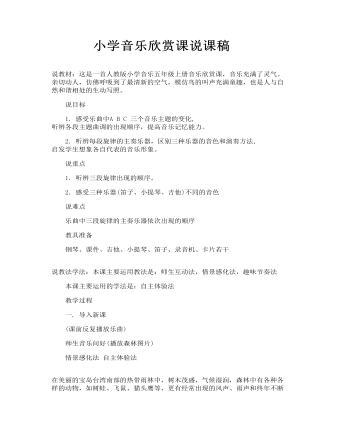
小学音乐欣赏课说课稿
1. 感受乐曲中A B C 三个音乐主题的变化, 听辨各段主题曲调的出现顺序,提高音乐记忆能力。 2. 听辨每段旋律的主奏乐器,区别三种乐器的音色和演奏方法, 启发学生想象各自代表的音乐形象。 说重点 1. 听辨三段旋律出现的顺序。 2. 感受三种乐器(笛子、小提琴、吉他)不同的音色 说难点 乐曲中三段旋律的主奏乐器依次出现的顺序 教具准备 钢琴、课件、吉他、小提琴、笛子、录音机、卡片若干 说教法学法:本课主要运用教法是:师生互动法,情景感化法,趣味节奏法 本课主要运用的学法是:自主体验法